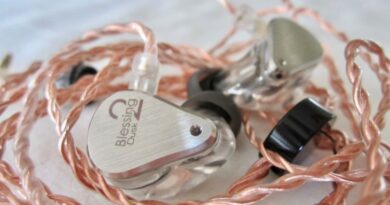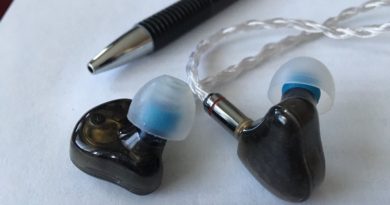TIN T5 Review – Faux Pas
Today we talk about the lastet iteration of TIN HIFI’s “T” series, called TIN T5.
In this Article
At-a-glance Card
| PROs | CONs |
| Commendable soundstage. | Slow, b[l]oomy bass. |
| Quite easy to drive. | Lean mids. |
| Easy fit, very good comfort and above average isolation. | Below average on imaging and details. |
| Sibilance risk on high mids | |
| Low value |
Full Device Card
Test setup
Sources: Apogee Groove / Questyle QP1R / Sony NW-A55 mrWalkman – Final-E white tips – Stock cable – lossless 16-24/44.1-192 FLAC tracks.
Signature analysis
| Tonality | TIN T5’s timbre is quite dry and lean-ish, excpted for boomy bass. Tonality is a warmish W, with an invasive midbass and occasional artificial aftertastes in the trebles. |
| Sub-Bass | Extended all the way and quite present too, this segment is OK |
| Mid Bass | On the slow side, too bloomy in general, scarcely articulated, and boomy, invasive whenever a hit lands onto the kick-drum (or equivalent). |
| Mids | Unrecessed but most of all lean, almost thin. Their higher segment succeeds in not being shouty but by a narrow edge, while it does go sibilant more often then not. |
| Male Vocals | Quite hollow, and unstructured |
| Female Vocals | Not a masterpiece but a bit better than males. Sibilance is their primary failure risk |
| Highs | TIN T5’s trebles are strange insofar as they are generally polished and “educated”, but with an incoherent tendence to get splashy on some tracks. Not enough brilliance or air is present to make them really engaging |
Technicalities
| Soundstage | Expansive especially in the sense of width and height, with decent depth too. Probably the single best feature of the product |
| Imaging | Below average considering the price tag. |
| Details | Midbass b[l]ommyness covers details down there. Mids are too lean and unbodied in the first place to offer good vocal details either. Some hint of detail is finally delivered in the highmids and Presence. |
| Instrument separation | Good, where not screwed by the midbass bloom – which is often the case on many genres. Layering is anyhow appreciable |
| Driveability | No problem with any of my sources, but I guess there won’t be with lower end ones either: TIN T5 features uncommonly (for an IEM) high impedance and decent sensitivity. |
Physicals
| Build | Full metal structure and recessed (read protected) cable connectors offer convincing durability |
| Fit | Quite big in size but very well shaped, TIN T5’s housings fit my ears almost perfectly. Nozzles are also decently long so there’s no induced instability issue nor any need to push them in too much. |
| Comfort | Very comfortable as a consequence of a very natural fit |
| Isolation | TIN T5 offer me above average isolation due to their housings filling my concha properly, and with no stress on my tragus |
| Cable | The stock cable is a base-quality 4-core OFC which sonically does its job properly. The sheat is a tad too stiff for my taste but that’s a detail. A word of mention is in order about the 2pin receptacles which are seriously recessed and make most third party 2pin male connectors inadequate to take over. |
Specifications (declared)
| Housing | Aviation grade aluminum housings |
| Driver(s) | 10mm DOC dynamic driver |
| Connector | 2pin 0.78mm |
| Cable | 4 core Oxygen-free copper with 3.5mm single ended termination |
| Sensitivity | 103 dB |
| Impedance | 48 Ω |
| Frequency Range | 10-20000Hz |
| Package and accessories | Leatherette carry case, spare nozzle mesh filters, cleaning brush, 1 pair of foam tips, 1 set of S/M/L narrow bore silicon tips, 1 set of S/M/L wid(er) bore silicon tips |
| MSRP at this post time | $139,00 ($119 street price) |
A new driver technology
TIN HIFI claims to have developed a new iteration in carbon-based dynamic driver technology, named “DOC”.
In the recent few years, DLC (Diamond-Like Carbon) dynamic drivers have been popular for their fast responsiveness, achieved by their carbon material. From this foundation, Tin Hifi has engineered the next innovation in dynamic driver technology. The new 10mm DOC driver features an enhanced molecular carbon atom structure and composition that more closely mirrors that of diamond. The new structural design allows the DOC diaphragm to be thinner, while being 60% stronger and more rigid than that of traditional DLC diaphragms. Furthermore, due the closer proximity of the carbon atoms to each other, the DOC driver is 5 times harder than that of typical ceramic diaphragms.
Moreover, the physical properties of the DOC diamond diaphragm will not change even after many years of use. This feature has a great effect on the heat dissipation of the voice coil. Additional benefits of the DOC includes:
1. The DOC diamond diaphragm unit can achieve a complete linear frequency response, achieving detailed and excellent broadband and instant response, and strong dynamic contrast.
2. The DOC diamond diaphragm unit can push the split vibration frequency to a higher level, and the T5 can cover an unimaginable bandwidth range to ensure that the ideal frequency response is obtained in the two end frequency bands audible to the human ear.
3. The frequency linearity that the DOC diaphragm provides allows the mid-frequency to be completely coherent with the bass and the treble, creating a transparency in the texture and sound balance, while minimizing phase offsets.
In short, the T5 achieves an immensely punchy bass response that is combined with extremely well-extended and detailed ultra-high frequencies. The textural properties of its sound is characterized by a cohesive smoothness, linearity, and transparency across the frequency spectrum. The DOC driver is an innovation that is just as audible as it is industry-leading.
https://www.tinhifi.com/products/tinhifi-t5?fbclid=IwAR0AofV1gqTut_O8bJB8HqhgL5gS0hyk4tEIc6ikg95zHwdXZIT_JIZXeT8
We all obviously are keen on new technologies improving audio rendering and TIN’s research is an interesting step in this direction.
Based in my audition, and reading through the marketing jargon, I could verify points 1. (good dynamic contrast) and 2. (good bilateral extension), while point 3. (choerence and texture transparency) is actually where T5 falls short. I’m keen on thinking this will be taken care of in a further TIN model, again based on such new “DOC” driver.
Conclusions
TIN T5 is in my opinion a faux pas in the otherwise mostly positive T-series. Both models I assessed prior to this one (T4 and T2+) offer better overall sound quality and value, with soundstage amplitude being T5’s sole edge vs its older siblings.
A generous-sized and drawn stage, and a great physical housing design granting superb fitting and comfort are anyhow not enough to compensate for lack of refinement in most segments of the spectrum, and a price tag which puts TIN T5 in direct competition with solidly established battleships (final E4000, anyone?).
Disclaimer
This TIN T5 sample has been kindly made available by TIN HIFI. You can purchase it here.
Our generic standard disclaimer.
You find an INDEX of our most relevant technical articles HERE.











